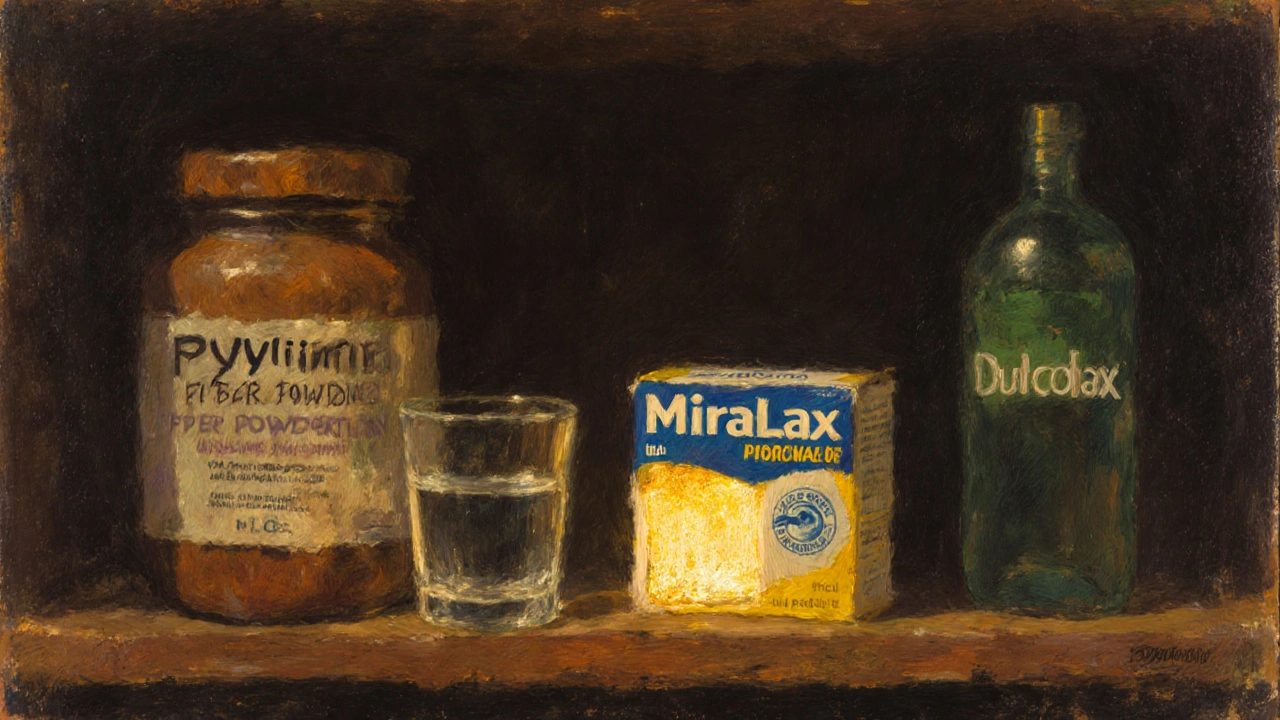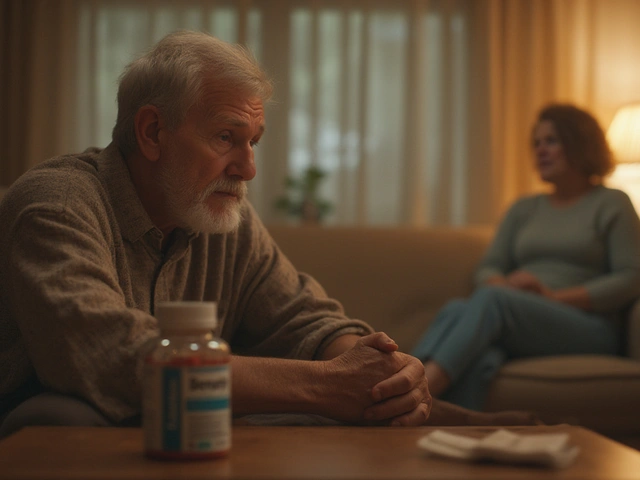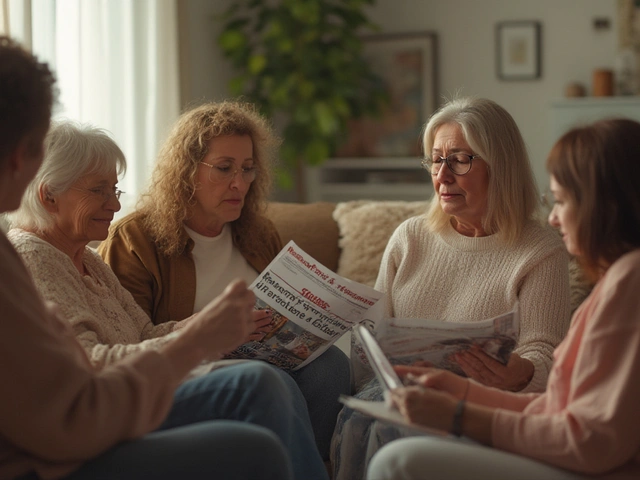What’s Really Working for Constipation? Not All OTC Remedies Are Created Equal
If you’ve ever sat on the toilet for 20 minutes with no result, you know how frustrating constipation can be. It’s not just uncomfortable-it messes with your whole day. The good news? You don’t need a prescription to find relief. Over-the-counter options like fiber supplements, stool softeners, and laxatives are on every pharmacy shelf. But here’s the catch: not all of them work the same way, and some can do more harm than good if used wrong.
According to the American Gastroenterological Association, about 1 in 6 adults deal with constipation regularly. That number jumps to 1 in 3 for people over 60. And with more people taking opioids, antidepressants, or iron supplements, it’s only getting more common. So you’re not alone. But choosing the right remedy? That’s where most people get stuck.
Fiber Supplements: The Gentle Start
Fiber is often the first thing doctors suggest-and for good reason. Bulk-forming laxatives like psyllium (Metamucil, Citrucel) soak up water in your gut and turn into a soft, spongy mass that pushes stool along naturally. Think of it like a sponge in a pipe: it expands, clears the blockage, and moves things along without forcing anything.
These work slowly-usually 12 to 72 hours. That’s not fast, but it’s safe for daily use. Clinical studies show they help about 55% of people with chronic constipation, compared to 35% on placebo. That’s solid. But here’s the deal: if you don’t drink enough water, fiber can make things worse. Seriously. It can harden into a blockage. Always take it with at least 8 ounces of water. And start low-5 grams a day-then slowly bump up to 25-30 grams over two weeks. Otherwise, you’ll end up bloated, gassy, and even more stuck.
Cost-wise, a 30-dose bottle runs $8-$15. That’s cheaper than most prescription meds. And unlike other options, you can use fiber long-term without worrying about dependency. It’s not a quick fix, but it’s the foundation for healthy digestion.
Stool Softeners: Often Overhyped
Docusate sodium (Colace) is everywhere. It’s in combo packs, in kids’ formulas, even sold as a post-surgery must-have. But here’s the truth: it doesn’t do much.
Stool softeners work by letting water and fat seep into hard stool, making it easier to pass. Sounds logical, right? But when researchers looked at 20+ clinical trials, docusate only beat placebo by 15%. That’s barely better than nothing. WebMD users gave it a 2.8 out of 5 rating-with 62% saying it had “minimal to no effect.”
It might help if you’re on painkillers or recovering from surgery and need to avoid straining. But if you’re just chronically constipated? Skip it. It won’t move the needle. And at $7-$15 for 100 capsules, you’re better off spending that money on something that actually works.
Osmotic Laxatives: The Gold Standard
If you want the most reliable, safest, and most effective OTC option, go with polyethylene glycol-better known as MiraLax or its generic versions.
How it works: it pulls water into your colon like a magnet. More water = softer stool = easier passage. No muscle stimulation. No cramping. No dependency. Just science.
Studies show 65-75% of people see improvement within 1-3 days. That’s way better than fiber (55%) or stool softeners (30%). And in head-to-head trials, PEG beat lactulose, senna, and even some prescription drugs. The American Gastroenterological Association gives it a top-tier “Grade A” recommendation. Dr. Brian Lacy from Dartmouth-Hitchcock says flat-out: “PEG should be first-line therapy.”
It costs $12-$22 for 30 doses. That’s about 40-75 cents per day. Take 17 grams (one capful) dissolved in water, once daily. Best time? After dinner. You’ll usually go the next morning. No urgency. No cramps. Just relief.
And here’s the kicker: it’s safe for months. Clinical trials tested it for up to six months with no serious side effects. That’s rare for any laxative. In fact, most people who try PEG stick with it-unlike stimulant laxatives, where 18% quit because of side effects.

Stimulant Laxatives: Fast But Risky
Bisacodyl (Dulcolax) and senna (Ex-Lax) work fast. Like, 6-12 hours fast. That’s why people reach for them when they’re desperate.
They zap your colon into contracting harder. Think of it like slapping your intestines awake. It works. But it’s harsh. About 25-30% of users get cramps. Some feel like they’re being stabbed. Others report sudden, uncontrollable urgency.
Reddit users who’ve tried Dulcolax say things like: “Effective but uncomfortable,” and “Worth it if you’re in pain.” Amazon reviews average 4.1/5-but the complaints are loud: “Intense cramps,” “Felt like I was going to pass out.”
And here’s the real danger: using these more than once a week for more than a week? You risk damaging your colon. Long-term use can lead to “cathartic colon”-where your intestines lose their natural ability to move stool without stimulation. It’s rare, but real. And it’s irreversible.
AGA guidelines say senna and bisacodyl are only for short-term rescue. Not daily. Not for weeks. Not for months. If you’re relying on these regularly, you’re treating the symptom, not the cause. And you’re risking your gut health.
Saline Laxatives: Use With Caution
Milk of Magnesia and magnesium citrate work fast-sometimes in under an hour. They pull water into the bowel like osmotic laxatives, but more aggressively.
They’re great for occasional use. Like if you’re traveling and your routine’s messed up. Or after surgery. But they’re not for daily use. Why? Because they can throw off your electrolytes. Magnesium can build up, especially if you have kidney issues. That leads to nausea, muscle weakness, or worse-heart rhythm problems.
Mayo Clinic warns: “Regular use can cause dehydration and electrolyte imbalances.” That’s not a risk you want to take unless you’re under a doctor’s care. A 12-dose bottle of Milk of Magnesia costs $4-$10. Cheap, yes. But not worth it for regular use.
What Should You Actually Use?
Let’s cut through the noise. Here’s a simple plan based on real evidence:
- Start with fiber-if you’re not already eating 25-30 grams a day from veggies, beans, oats, and whole grains. Add psyllium slowly.
- If fiber doesn’t help after 2 weeks, switch to PEG (MiraLax). Take 17g daily. Give it 1-3 days. Most people get relief by day 2.
- Only use stimulant laxatives (Dulcolax, senna) for emergencies. Like a 3-day blockage. One dose. Then stop.
- Avoid stool softeners as a main treatment. They’re not strong enough.
- Never use saline laxatives regularly. Too risky.
And always drink water. At least 64 ounces a day. Fiber and osmotic laxatives need it to work. Without it, they’re useless-or dangerous.

When to See a Doctor
OTC remedies are great for occasional constipation. But if you’ve tried everything for 7 days and nothing’s working, it’s time to call your doctor. Same if you’re losing weight, bleeding, or have severe pain. Constipation can sometimes be a sign of something bigger-like thyroid issues, diabetes, or even colon cancer.
Also, if you’re taking opioids, antidepressants, or iron pills, talk to your doctor before using any laxative. Some meds make constipation worse, and you might need a different approach.
What’s New in 2025?
The OTC constipation market is growing fast-now worth over $1.2 billion in the U.S. And things are changing. In 2023, the FDA approved MiraLax Plus, which adds electrolytes to help prevent dehydration. That’s a big deal.
Also, the American Gastroenterological Association updated its guidelines in June 2023, making PEG even more central to treatment. Meanwhile, companies are testing new products that target gut bacteria. Early results show they might be 15-20% more effective than PEG alone. Those could hit shelves by 2025.
But for now? Stick with what’s proven. Fiber first. PEG second. Avoid stimulants unless it’s an emergency. And never, ever use laxatives as a weight-loss tool. That’s dangerous-and it doesn’t work.
Real People, Real Results
On Reddit, 78% of users who tried MiraLax said they saw “significant improvement within 48 hours.” One wrote: “I’ve been stuck for weeks. One dose of MiraLax and I was fine. No cramps. No drama.”
On Amazon, MiraLax has over 28,000 reviews and a 4.5-star rating. Dulcolax? 15,000 reviews, 4.1 stars-with comments like: “Worked fast but I felt like I’d been hit by a truck.”
And here’s the thing: the people who succeed aren’t the ones who take the strongest stuff. They’re the ones who start slow, stay consistent, and listen to their body.
Final Tip: Don’t Mix Products
Combo packs (fiber + stimulant + stool softener) sound convenient. But they’re not smarter. They’re riskier. You’re layering weak treatments with dangerous ones. Stick to one type at a time. Know what you’re taking. And if you’re unsure? Ask your pharmacist. They’re trained for this.
Can I take fiber and MiraLax together?
Yes, but not at the same time. Take fiber in the morning with plenty of water. Take MiraLax in the evening. Taking them together can cause bloating or even blockage if you’re not hydrated. Space them out by at least 4 hours.
How long can I safely use MiraLax?
Up to 6 months, based on clinical trials. Many people use it daily for months with no issues. But if you’re still constipated after 3 months, see a doctor. There may be an underlying cause that needs attention.
Is Dulcolax safe for seniors?
It’s not ideal. Seniors are more prone to dehydration and electrolyte imbalances. Stimulant laxatives like Dulcolax can cause cramps, dizziness, or even heart rhythm issues in older adults. PEG is much safer and better tolerated. Most doctors recommend it as the first choice for people over 65.
Why does my constipation come back after I stop taking laxatives?
If you’ve been using stimulant laxatives regularly, your colon may have gotten lazy. It stopped responding to natural signals. Fiber and PEG don’t cause this-they help your body work normally again. If you’re stuck in a cycle, switch to daily fiber and PEG for 4-6 weeks. Then slowly reduce PEG while keeping fiber high. Your body will relearn how to move on its own.
Can I use OTC remedies if I have kidney problems?
Avoid saline laxatives like Milk of Magnesia-they can overload your kidneys with magnesium. Fiber and PEG are generally safe, but check with your doctor first. Some people with kidney disease need to limit fluid intake, which can make fiber risky. Always get personalized advice.





